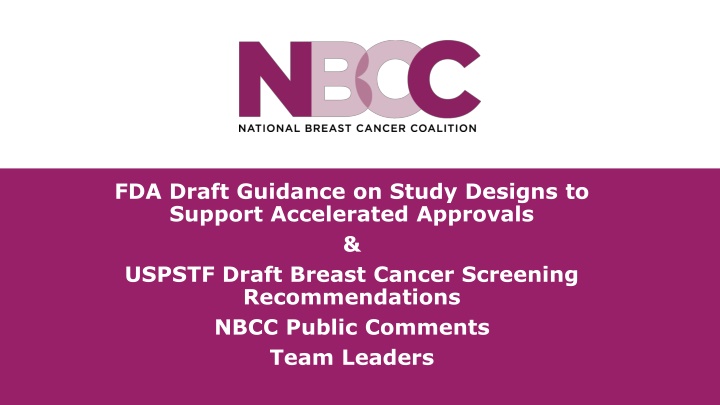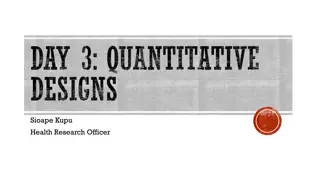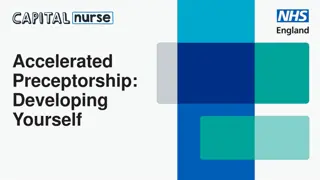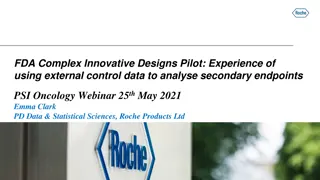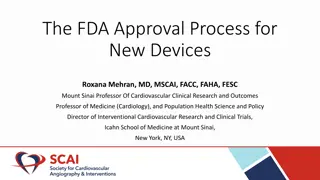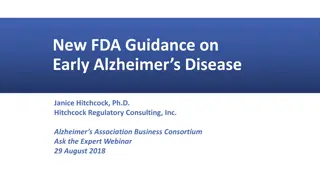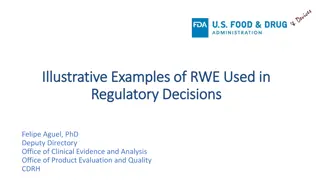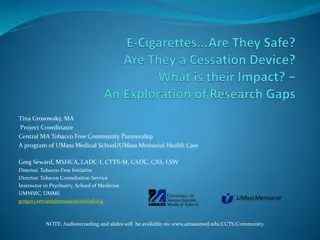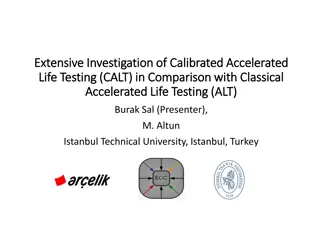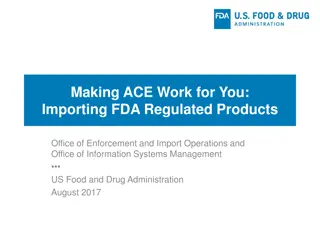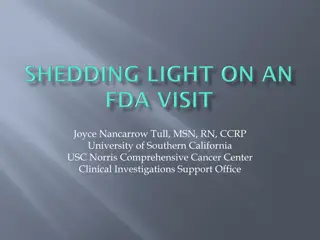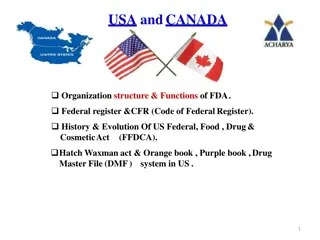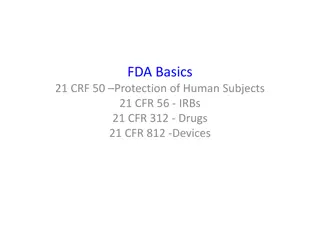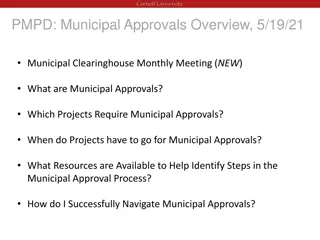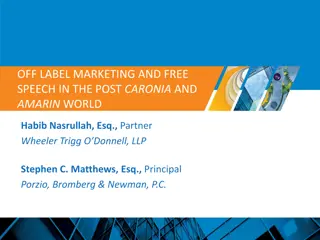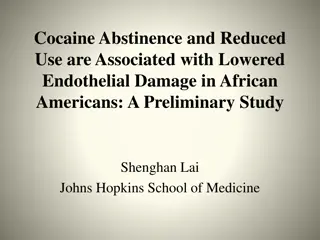FDA Draft Guidance on Study Designs for Accelerated Approvals
The FDA released draft guidance to support accelerated approvals and reduce clinical uncertainty by improving clinical trial study designs. The guidance outlines three study designs and specific considerations for each, aiming to minimize uncertainty for patients and encourage postmarketing confirmatory studies.
Download Presentation

Please find below an Image/Link to download the presentation.
The content on the website is provided AS IS for your information and personal use only. It may not be sold, licensed, or shared on other websites without obtaining consent from the author.If you encounter any issues during the download, it is possible that the publisher has removed the file from their server.
You are allowed to download the files provided on this website for personal or commercial use, subject to the condition that they are used lawfully. All files are the property of their respective owners.
The content on the website is provided AS IS for your information and personal use only. It may not be sold, licensed, or shared on other websites without obtaining consent from the author.
E N D
Presentation Transcript
FDA Draft Guidance on Study Designs to Support Accelerated Approvals & USPSTF Draft Breast Cancer Screening Recommendations NBCC Public Comments Team Leaders
FDA Draft Guidance for Sponsors on Accelerated Approval March 24 FDA released draft guidance for trial sponsors Docket No. FDA-2023-D-0110 for "Clinical Trial Considerations to Support Accelerated Approval of Oncology Therapeutics 60 days for public comments Due by May 26
Background on the Guidance Purpose: To encourage study designs for clinical trials that will improve the data available at the time of accelerated approval and reduce clinical uncertainty for patients by initiating postmarketing confirmatory studies in a timely manner. To minimize the period of uncertainty for patients.
Background on the Guidance Outlined 3 study designs and specific considerations for each 1. The traditional, 2-RCT approach (one using a surrogate endpoint for AA and a second confirmatory trial with a clinical endpoint) 2. Single RCT for both AA and regular approval (New) 3. Single-arm trial
Background on the Guidance 1. The traditional, 2-RCT approach (one using a surrogate endpoint for AA and a second confirmatory trial with a clinical endpoint) The confirmatory trial should have already started and be close to or have completed patient accrual. Alternatively, the confirmatory trial can be in an earlier disease setting
Background on the Guidance 2. Single RCT approach Preliminary surrogate endpoint for AA; and longer-term secondary clinical endpoint for conversion to regular approval Endpoints for this approach are critical Other design considerations discussed included: If crossover will be permitted Control arm treatment Combination regimens the need to be able to demonstrate the impact for each component of the regimen independently Plan for dealing with multiple endpoints and the potential for a false positive type-1 error (alpha splitting and hierarchical statistical plans) Trial size with enough power
Background on the Guidance 3. Single-arm trial considerations Endpoints like response rate Magnitude of response and the duration of response Blinded independent central review Available therapies and plans for comparing data to other therapies on the market for the condition Pre-specifying the historical control Sample size of the trial
NBCC Comment Primary concern: FDA continues to include progression-free survival (PFS) as a clinical endpoint NOT a measure of how a patient feels, functions, or survives.
NBCC Comment Primary concern: FDA continues to include progression-free survival (PFS) as a clinical endpoint PFS represents the time from randomization or the initiation of treatment to measurable (typically by radiographic measurement in solid tumors) disease progression or death. Progression is defined by the Response Evaluation Criteria in Solid Tumors as an increase in the sum of maximum tumor diameters of at least 20%, the development of any new lesions, or an unequivocal increase in non-measurable malignant disease. Originally developed to support the advancement of drugs in Phase 2 clinical trials to Phase 3 testing Subject to various forms of bias
NBCC Comment Other concerns we listed: Power of the trial to answer clinically-meaningful endpoint (like overall survival) FDA should provide strong language about ensuring trial sample is large enough to assess benefit of clinical endpoint Educated advocate involvement FDA should recommend the inclusion of educated patient advocates/advocacy organizations in trial design and implementation
USPSTF Breast Cancer Screening Draft Recommendations Released on May 9, 2023 30 days for public comment Due on June 5, 2023
CURRENT USPSTF Recommendations https://www.uspreventi veservicestaskforce.org /uspstf/recommendatio n/breast-cancer- screening#fullrecomme ndationstart
Definitions of USPSTF Grades https://www.uspreventiveservicestaskforce.org/uspstf/about-uspstf/methods-and- processes/grade-definitions
**DRAFT** USPSTF Recommendations (as of June 20, 2023) https://www.uspreventiveservicestaskforce.org/uspstf/draft-recommendation/breast-cancer-screening-adults
What Has Changed? No new empirical data Used the Cancer Intervention and Surveillance Modeling Network (CISNET models) with modified input data Breast cancer natural history, breast cancer treatment benefit, breast cancer incidence, screening benefit from RCTs, stage distribution among diagnosed cancers, ER/HER2 subtype distribution, etc. Increased incidence of breast cancer among 40-49 year olds (~2% annually between 2015-2019) The six models were independently developed and all replicate breast cancer incidence and mortality in the US female population. The models use common data inputs but each modeling team makes independent assumptions regarding the natural history of breast cancer and how the data inputs are incorporated into the models. https://www.uspreventiveservicestaskforce.org/uspstf/document/draft-modeling-report/breast-cancer- screening-adults
What They Found From Models (2016) Each of the six modeling approaches found different estimates for each potential benefit and harm considered. In 2016 (the last USPSTF update) Lowering the starting age for screening from 50 years to 40 years would result in 1.0additional breast cancer death averted (going from 7 to 8 deaths averted) for every 1,000 women screened over a lifetime. As a result, screening in this age group (40-49 years) was given a C level recommendation, making the decision to start screening during this period, an individual one.
What They Found From Models (2023) In 2023 (current draft USPSTF recommendation) Lowering the starting age from 50 years to 40 years for biennial mammography would result in 1.3 more breast cancer deaths averted (all women; going from about 7 to 8.3). Yes, 0.3 more breast cancer deaths averted compared to the 2016 recommendation. In Black women specifically, the collaborative modeling analysis also found that 1.8 more breast cancer deaths would be averted for every 1,000 Black women screened over a lifetime. The recommendation change is largely motivated by the large disparities in breast cancer outcomes for Black women.
Estimated Harms of the Age Change A ~60% increase in false-positive results (going from 873 false-positive results to 1,376) A ~36% increase in benign biopsies (going from ~148 to 210) An additional2 cases of overdiagnosis (going from 12 overdiagnosed cases to 14) (Note: there was a large amount of variation across the models regarding the impact on overdiagnosis, from as few as 4 cases to as many as 37 overdiagnosed cases.)
Limitations of the Models ALL of the models assumed 100% screening adherence, prompt evaluation of abnormal screening results, and appropriate and timely access to treatment. BEST CASE SCENARIO BUT NOT THE REAL SCENARIO
What Screening Is Already Going On in This Age Group? According to the CDC, ~60% of all women between 40-49 years of age are already being screened. https://www.cdc.g ov/nchs/hus/topics /mammography.ht m#featured-charts
What Screening Is Already Going On in This Age Group? According to the CDC, ~60% of all women between 40-49 years of age are already being screened. https://www.cdc.g ov/nchs/hus/topics /mammography.ht m#featured-charts
What Screening Is Already Going On in This Age Group? https://www.cdc.g ov/nchs/hus/topics /mammography.ht m#featured-charts
NBCC Statement Screening with mammography will not eliminate the long-standing disparities that exist in breast cancer outcomes regardless of the start and stop age. They are the result of structural racism, and the health care policies that create inequitable access to appropriate, timely, and quality care.
NBCC Statement Diverting billions more dollars each year to an ineffective or at best, weakly effective intervention like screening that includes so much harm diverts those resources from addressing the tough questions, like how we prevent breast cancer or stop it from becoming lethal and how to create an equitable health care system. Mammography screening is not the answer to ending breast cancer and saving lives, and continued emphasis on it as a dominant strategy is misplaced.
